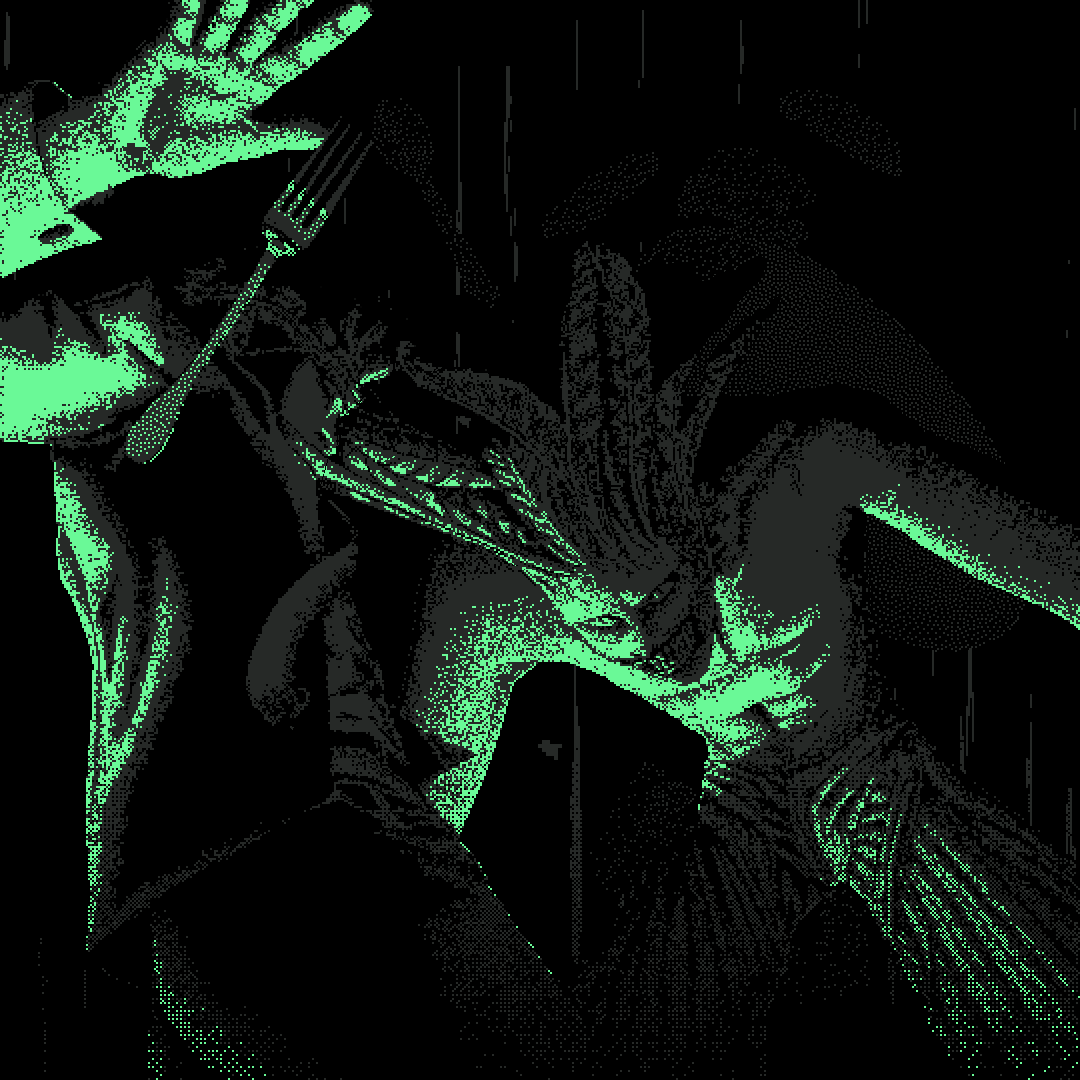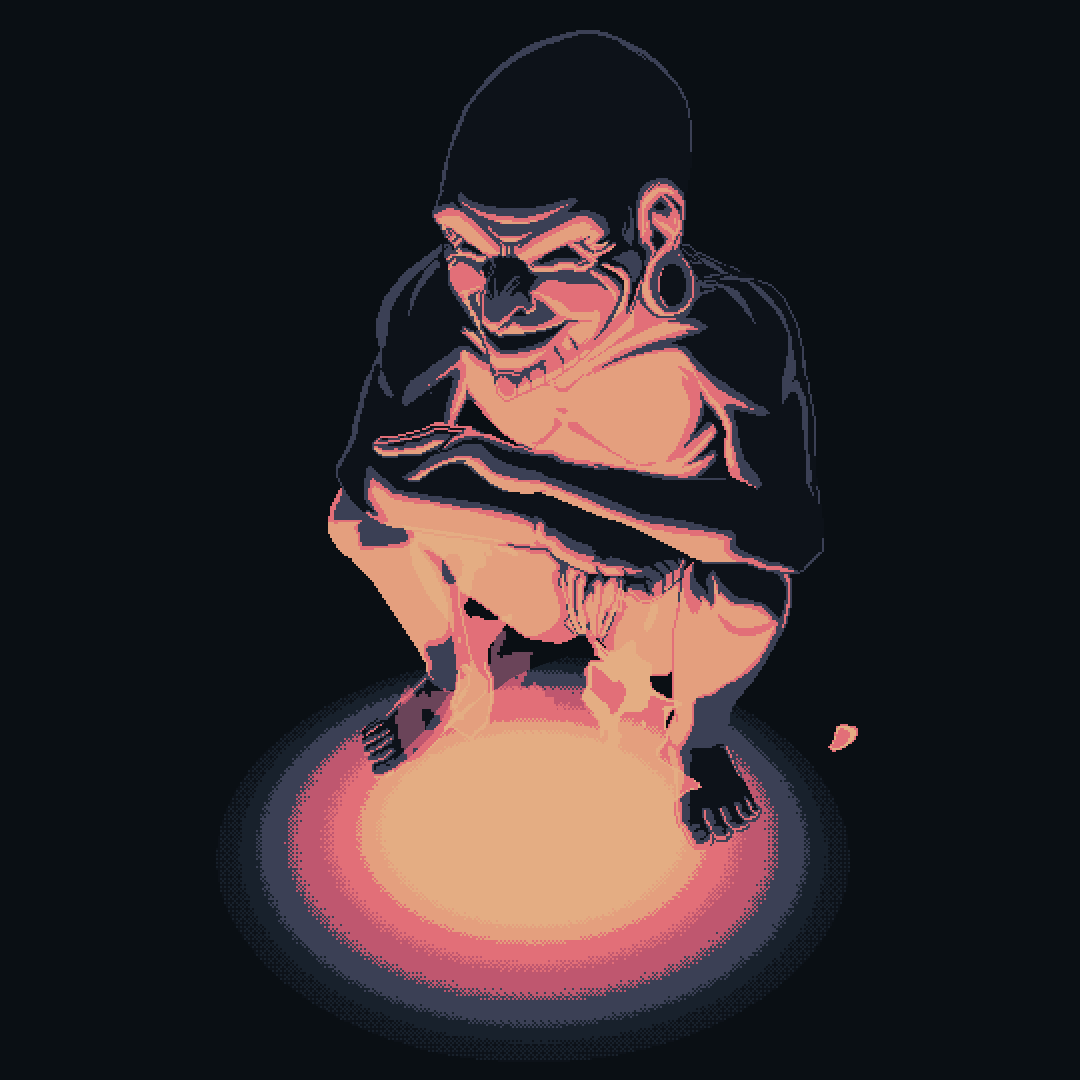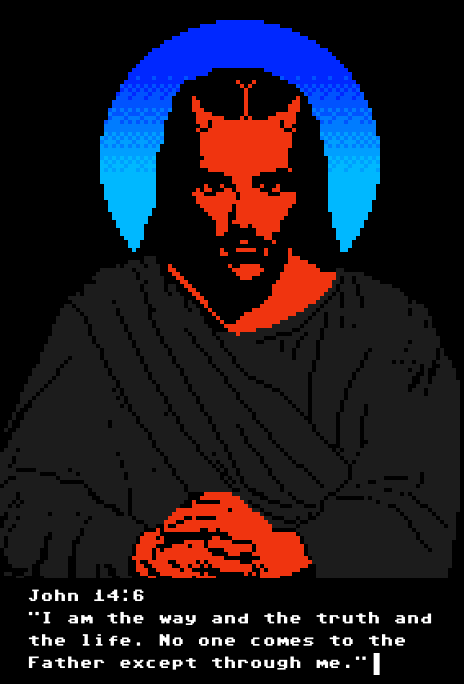Pixel chlorophyll: horror, conflict, and harmony in the works of Criptocromo
The Flavoprotein Artist
Blue light-sensitive flavoproteins called cryptochromes contribute to regulating directional growth in plants, and in some species even have a role in controlling circadian rhythms. It’s an apt moniker for Mexican artist Criptocromo, whose body of work includes imagery inspired by greenery. His pixel art is frequently rendered in bold and contrasting tones, with subject matter veering into the unsettling. “I’ve always been interested in the plant kingdom,” he said when we spoke over video. “It all started, I think, since I was a child. I got carnivorous plants.” Over time, he began to learn more about plant biology and took gardening workshops. In his profile on SuperRare, he even describes himself as a “flavoprotein artist.” But his previous job, creating television graphics for a news channel, was not one that allowed him to explore what he finds fascinating and inspiring. In 2014, he began creating digital art and posting it on Tumblr to satisfy the need to express himself; he first came into contact with NFTs by following XCOPY on the platform, and curiosity took hold. “I sent my animation to SuperRare. I said, ‘let’s see what happens.’ I wasn’t even into cryptocurrencies.” To his surprise, they accepted his art.
Criptocromo, a soft-spoken man in his thirties with an inviting smile and thick square glasses, minted his first token on SuperRare about four years ago (the piece, “Domestication,” referencing “The Creation of Adam,” depicts a hand reaching towards the leaves of a plant and includes a text box similar to those found in retro video games); he’s been in the crypto art space ever since, minting not only on SuperRare, but also on platforms ranging from Rarible to Hic et Nunc. And plant life isn’t the only notable feature of his art. Criptocromo’s work is full of very fine pixels where shadow, shading, and color express the horrific and grotesque. Most tokens are not still images, but rather pulsing GIFs that produce disquieting emotions in the observer.
For example, “Lettuce” invites the viewer to a dark scene bathed in eerie neon green light, where a towering plant monster emerges from the shadows. A human victim drops their fork. The subtle wafting of the leaves on the monster’s head as rain pounds down around it makes the scene all the more haunting. When I asked Criptocromo about the relationship between nature and humans present in his work, he paused for a moment and apologized as he dug for the right words to express himself in English. But I suspected based on his demeanor, the way his eyes seemed to flicker after each question, that regardless of what language he found himself communicating in, Criptocromo often spoke thoughtfully. After a few moments, he explained, “we are all living organisms. We come from a living organism.” The domination of humans by plant life and the absorption of humanity into nature are both very present across his body of work, this feeling that the plant kingdom is executing revenge upon humanity for how we have systematically destroyed it.

“Skeletal Garden” explores similar concepts but more quietly—the art shows a skeleton awash in golden light over a backdrop of night skies and deep indigo mountains, dark turquoise grass dotted with white and blue flowers. It appears to be growing from the ground and simultaneously sinking into it, at rest but somehow alive. The sentence “Congratulations! You managed to grow a beautiful garden…” floats in a text box. As Criptocromo explained, the piece considers how death can bring life, how a decaying creature can help produce a thriving garden by giving itself back to the earth. “It’s more to see the transcendental part,” he said.
He similarly explores the relationship between life and death in “Xiuhtecuhtli.” In “Xiuhtecuhtli,” the eponymous Aztec god, known as the god of fire but also associated with life after death, rebirth and transformation, crouches low over a flame as if about to lower himself into it, grinning with his arms crossed over his knees. And in “LuciferChrist,” Jesus and Lucifer are depicted as a single being, with red skin, horns, and a flashing blue halo. A text box below quotes John 14:6: “I am the way and the truth and the life. No one comes to the Father except through me.” Criptocromo continuously coaxes harmony from the space between seemingly conflicting forces, be it life and death, people and nature, good and evil. I asked him about the presence of spirituality in his work, but when he suddenly became bashful, I realized that through our language difference and the spotty audio connection of our video chat, he thought I asked him about sexuality in his art instead. I didn’t correct him because I thought that either way, his answer would provide fascinating context. He said it wasn’t a focus of his work, but “I love the symbols,” sharing that he’s become interested in lucid dreaming. “It has more to do with grading your own language and symbols and trying to make sense of your own imagery.” He added that artists should listen to the dark sides of their personalities, as creatively those are “routes where great things are hidden.”
Beyond Sprites
Not all of Criptocromo’s pieces include the text boxes, but many do. Even those that don’t are inspired by vintage gaming, most obviously through the use of pixels, but also through backgrounds, color, and aspects of character design. According to Criptocromo, nostalgia remains a strong factor in the look of his work—he grew up playing vintage games and considers it a “very generational influence.” But he rightfully differentiates his particular style from art that simply reproduces the aesthetics of retro gaming: “I am not so much interested in pixel art formally speaking, like creating sprite animation…I try to give my artwork a more illustrative approach.” And while the impact of classic games is evident (he cited “Donkey Kong Country” for the SNES as a favorite, but shared that he recently played “Undertale,” a contemporary game with classic pixel graphics that subverts traditional dungeon crawler narratives), Criptocromo expressed that he wants to get deeper into “the texture side of the artwork, of the noisy pixels moving.” The chilling “GN” exemplifies this, showing cloaked blue figures whose crimson eyes beat and crackle in time with background pixels, reminiscent of the 1973 René Laloux film “Fantastic Planet.” Criptocromo loves the GIF format for this reason, saying that “It looks more crisp. It’s sharp. It’s more malleable, maybe.”
These qualities are what drew me to his work initially–my tastes in visual art are squarely rooted in pixels, glitches, and noise, references to retro tech, vintage A/V equipment, and old games; he elevates that style. And while there are other crypto artists whose work exists in a similar vein–contemporaries like Neurocolor, Sarah Zucker, and p1exlfool–Criptocromo doesn’t have the sizeable online following many of these artists have, despite the time he’s spent in the scene. Something about his work still feels alternative and underground, I think in part because his art specifically builds upon the aesthetics of video games, conjuring images of small groups of people huddled around early consoles in private living rooms. His use of light, color, and shadow are reminiscent of low budget creature features with terrifying practical effects, but the accessibility of his art also plays a role in fostering this DIY quality–though his pieces on SuperRare and other Ethereum-powered platforms fetch higher prices, Criptocromo still has tokens available on Hic et Nunc for 25 XTZ and under, or, as of writing, less than $100.
And his work goes beyond still images and GIFs. He minted an animated NFT on SuperRare called “Circum[n]utation;” it features Spyder Malamadre, a character frequently featured in Criptocromo’s art, destroying a city—the animation is thirty-two seconds long, inspired by ‘90s video game intros, and has music composed by Adrián Baez. Music is another interest—he’s released a few volumes titled “Music for Plants,” available on SoundCloud and Youtube, but doesn’t exactly consider himself a musician. Inspired by experimental techno, darkwave, IDM, and ambient soundscapes, his music rides the sounds of lo-fi, dungeon crawler scores, and occasionally even gives remnants of Mort Garson’s internet-beloved “Plantasia.”
Now, Criptocromo has built strong bonds with fellow artists and collectors. Of the community, he said, “I think if it wasn’t for them, I don’t know if I would still be here…there’s a sense of unity and it’s very magical.” His face lit up when he described drawing inspiration and comradery from artists like XCOPY, Ofiicinas TK, and Carlos Marcial, and he’s specifically enthusiastic about the crypto art community in Mexico, his home. In addition to minting art and exploring music composition, he’s excited about participation in a platform focused on comics, an unexplored space for crypto artists in comparison to other mediums. Ultimately, he loves the scene and the place he’s carved out for himself in it. “I didn’t even imagine that we could have all of this community going,” Criptocromo said. “So I dunno. Growing so fast, it has been really a nice experience and I am very thankful.”

Oliver Scialdone is a queer writer and artist based in Brooklyn, NY. They earned a dual-MFA from The New School, and their work can be found in Peach Mag, ImageOut Write, and elsewhere. They used to host the reading series Satellite Lit and they're the Associate Editor at SuperRare Magazine.
Art

Curated Conversations: ALIENQUEEN
SuperRare Labs Senior Curator An interviews ALIENQUEEN about psychedelics, death, and her journey in the NFT space.
Tech


Out of the Vault and onto the Chain: the Evolving Nature of Provenance
SuperRare editor Oli Scialdone considers the social experience of provenance and its relationship with community in the Web3 space.
Curators' Choice



Curated Conversations: ALIENQUEEN
SuperRare Labs Senior Curator An interviews ALIENQUEEN about psychedelics, death, and her journey in the NFT space.






